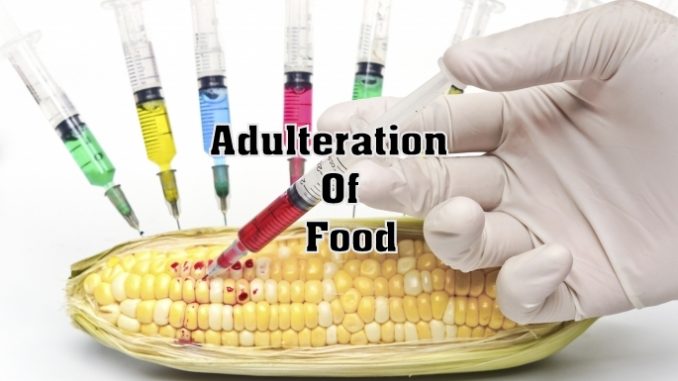
INTRODUCTION:
- Food Adulteration refers to the process by which the quality or the nature of a given food is reduced through addition of adulterants or removal of vital substance.
- Food adulterants refer to the foreign and usually inferior chemical substance present in food that cause harm or is unwanted in the food.
- Basically, during food adulteration, small quantity of non-nutritious substances are added intentionally to improve the appearance, texture or storage properties of the food.
- Food adulteration is quite common in the developing countries.
FOOD IS ADULTERATED IF:
- The food sold does not meet the nature of the substance or quality as per the demand of consumer.
- The food contains inferior or cheaper substance
- The food has been prepared, packed or kept under unclean conditions leading to contamination.
- Food contains substances that depreciates or injuriously affects the health.
- If the food’s original nature is substituted wholly or partially by abstracting a portion of vital substance from food.
- If it is an imitation of some other food substance.
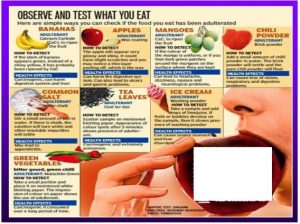
CAUSES OF FOOD ADULTERATION:
- Profit motive of traders: Done as a part of the business strategy
- Food insecurity: To increase quantity of food production and sales.
- Increased Urbanization: To make maximum profit from food items by fewer investments.
- High population demands: Increased food demand of the population and its changing trends.
- Illiteracy of general public: Lack of consciousness of proper food consumption.
- Lack of effective food laws
- Lack of government in initiative
TYPES OF FOOD ADULTERATION:
- Intentional adulteration: The adulterants are added as a deliberate act with intention to increase profit. E.G. sand, marble chips, stones, chalk powder, etc.
- Incidental Adulteration: Adulterants are found in food due to negligence, ignorance or lack of proper facilities. E.G. Packaging hazards like larvae of insects, droppings, pesticide residues, etc.
- Metallic adulteration: When the metallic substances are added intentionally or accidentally. Eg: arsenic, pesticides, lead from water, mercury from effluents, tins from cans, etc.
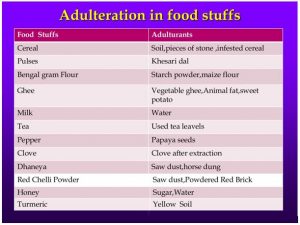
METHODS OF FOOD ADULTERATION:
- Mixing: Mixing of clay, stones, pebbles, sand, marble chips, etc.
- Substitution: Cheaper and inferior substances being replaced wholly or partially with good ones.
- Concealing quality: Trying to hide the food standard. E.G. adding captions of qualitative food to low quality for selling.
- Decomposed food: Mainly in fruits and vegetables. The decomposed ones are mixed with good ones
- Misbranding/ False labels: Includes duplicate food stuffs, changing of manufacture and expiry dates.
- Addition of toxicants: adding non-edible substances like argemone in mustard oil, low quality preservatives, colouring agents, etc.
FOOD ADULTERATION IN DEVELOPING COUNTRIES:
- Fresh vegetables and fruits, the main part of our meal is adulterated by the self applied fertilizers and pesticides by the farmers to increase the production and to avoid the attacks of insects and diseases.
- Wax coating/ dipping in chemical water like copper sulphate (CuSO4) is used for increasing the marketing by making them attractive and fresh looking.
- Nowadays, vegetables producing fields are irrigated with sewerage water which included detergents, human faeces, factory wastes having high concentrations of toxic heavy metals i.e. lead and arsenic which can cause damage to liver, kidney and cancer.
- Vegetables and fruits are also openly sold at roads which cause the free fallen smoke and dust particles resulting in contamination.
- Screen is used as sweetening agent in many confectionary products, instead of sucrose, which is harmful for health
- The storage room are cleaned and fumigated to protect the storage products from insects which contain hazardous substances affecting the health.
- Brick dust is added in chilli powder on the other hand lead chromate and metanil yellow is added in turmeric powder that deteriorates health condition.
- Sugar and salt is adulterated with calcium carbonate, similarly urea is mixed in parched rice.
- The saw dust is added in coriander powder and cumin powder.
- The sodium bicarbonate in jaggery, coal tar dye in tea leaves, metanil yellow colour in gram powder.
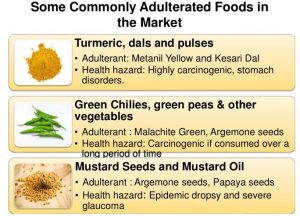
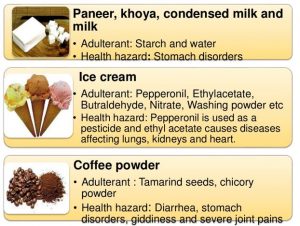
HEALTH HAZARDS OF FOOD ADULTERATION:
Some health hazards associated with specific food adulteration incudes;
- Mineral oil if added to edible oil and fats can cause cancers.
- Lead chromate when added to turmeric powder and spices can cause anaemia, paralysis, brain damage and abortions.
- Lead added to water, natural and processed food can lead to lead poisoning, foot drop, insomnia, constipation, anaemia, and mental retardation.
- Cobalt added to water and liquors and can cause cardiac damage also copper, tin, and zinc can cause colic, vomiting and diarrhoea.
- Mercury in mercury fungicide treated grains, or mercury-contaminated fish can cause brain damage, paralysis, and death.
- Non-permitted colour or permitted food colour like metal yellow, beyond the safe limit in coloured food can cause allergies, hyperactivity, liver damage, infertility, anaemia, cancer and birth defects.
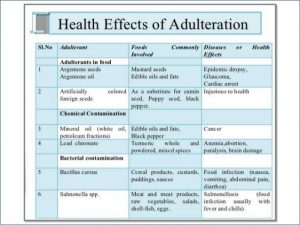
MITIGATION MEASURES FOR ADDRESSING FOOD ADULTERATION:
- There must be proper surveillance of the implementation food laws.
- There should be monitoring of the activities with periodical records of hazards regarding food adulteration.
- There should be periodical training programmes for Senior Officer/Inspector/Analysts for food safety
- There should be consumer awareness programmes organized by holding exhibitions/seminars/training programmes and publishing pamphlets.
- There should be strict actions regarding the punishment for those who are involved in food adulteration.
- There should be help and support from International INGOs for implementation of food laws.
REFERENCES AND FOR MORE INFORMATION:
https://www.slideshare.net/enigmisha/food-adulteration-52244831
https://www.slideshare.net/RizwaanMohammed/food-adulteration-52408347
https://www.slideshare.net/rifatnaz61amc/food-adulteration-54846488
https://www.slideshare.net/ElakkiyaThangaraju/adulteration-65185398
https://www.slideshare.net/moocsengine/adulteration-in-foods
https://www.slideshare.net/esfaquel/food-adulteration
https://myessaypoint.com/harmful-effects-food-adulteration
https://technologytimes.pk/post.php?title=Hazards+of+food+adulteration+in+human+health
http://tripti.expertscolumn.com/article/some-facts-about-food-adulteration
http://foodravel.com/2016/07/29/food-adulteration/
http://earthuntouched.com/food-adulteration-impact/
http://essayarticle.com/food-adulteration/
https://www.slideshare.net/msdhillon72/the-prevention-of-food-adulteration-act
https://archive.india.gov.in/sectors/health_family/food_prevention.php
https://www.slideshare.net/PrajeeshNath/pfa-62880422
https://www.slideshare.net/dipteshpatil32/the-prevention-of-food-adulteration-act-1954
http://extwprlegs1.fao.org/docs/pdf/ind10950.pdf